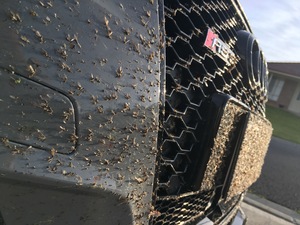Moses Ziyambi
While something puny as bug splatter on car windshields and grilles means very little or nothing to many motorists, it could be a very significant indicator of the environmental and ecological status of a given area.
These are the concerns raised by a veteran conservationist who worries that the fewer squashed bugs and other flying insects on vehicles could be a sign of a larger environmental problem that is putting seasonal insects under severe pressure.
Arthur Harmsworth, who has spent several years studying small insects particularly butterfly species of the Savanna, says he has noticed a marked decline of bug splatter on cars that stop at fuelling stations in the Lowveld town of Chiredzi.
“A few years ago, when vehicles arrived at the filling station to get fuel, one would see a lot of bug splatter on the radiators, front grills and windscreens. You hardly see it these days. This could be indicative of a massive decline in flying insect numbers,” Harmsworth told EnviroPress.
The veteran conservationist says the tumbling population of those flying insects would have a knock-on effect on the various birds and small animals that feed on them.
In Zimbabwe, such insects and bugs as moths, termite alates (ishwa) and non-edible flying termites (mabhururungwa) make much of the splatter as they swarm to moving vehicle lights especially in wet nights.
“The possible cause of that decline are climate change, or changing weather patterns at the very least; habitat loss due to urban sprawl; increased farm areas where natural vegetation is cleared; as well as widespread use of pesticides and herbicides,” said Harmsworth.
He said there was need for more empirical studies to understand local bug and fly populations as well as their relationship with an environment characterised by expanding human-induced changes.
“In South Africa, there is a groundswell towards re-wilding gardens in urban areas by planting and encouraging the growth of indigenous plants and trees rather than having manicured gardens full of alien plant species. I believe that kind of movement is also required in Zimbabwe; the understanding that in conservation culture, local is better than alien,” said Harmsworth.
Fauna and Flora Zimbabwe (FafloZim) director Fidelicy Nyamukondiwa said he was convinced that a decline in insect population at any given place and time is often attributable to increased use of pesticides and habitat loss as a result of human activities.
“This might appear immaterial but it is a serious cause for concern. When large populations of insects disappear, it has a bearing on ecosystems and it can affect pollination in plants. This in turn becomes a threat to the survival of some plant species,” said Nyamukondiwa.
In her book Climate Change in Zimbabwe, leading researcher Anna Brazier says it is projected that a quarter of Earth’s species are at risk of extinction if global warming continues.
“Many animals will lose their habitats and die as vegetation patterns change and water becomes scarce,” she says.
In the United Kingdom, a new mobile application called Bugs Matter was launched in 2021 by the Kent, Gwent, Essex and Somerset Wildlife Trust to help survey insect populations and to help conservationists understand how the insects are faring.
The downloadable ‘splatometer’ allows users to easily count the number of bugs squashed on number plates and to submit the count via the same app.
This report was made possible through support from WAN-IFRA Media Freedom’s Strengthening African Media Programme: Climate Change and Environmental Reporting. Views expressed here do not belong to WAN-IFRA.






